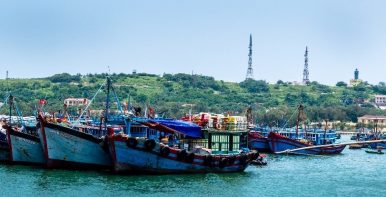By Zhen-Gang Ji
In 1957, as the Vietnam War escalated, the most strategic island in the Gulf of Tonkin was secretly transferred from China to Vietnam. This island, called Bach Long Vi (BLV), has long been regarded as essential not only for security and defense, but also for oil and gas exploration, marine economic development, and environmental conservation in the area. It is also an important fishery with enormous potential in seafood processing, fishing logistic services, and maritime preservation.
BLV is the largest habitable island in the entire South China Sea, which is one of the world’s busiest waterways. An estimated a third of the global maritime trade passes through the South China Sea. This area is subject to several overlapping territorial disputes involving multiple countries, which sparked armed conflict between China and South Vietnam in 1974. The disputes have remained unresolved for decades and have emerged as a flashpoint in Asia.
Against this thorny history, the case of BLV stands out. The island was under Chinese control until the 1950s. Then BLV was secretly surrendered to North Vietnam in 1957, so that the island could host a new radar base to provide an early warning of American planes and serve as a transitional post for Chinese aid materials. BLV has been controlled by the Vietnamese government ever since. Today, it is a military restricted area and only Vietnamese citizens are allowed to enter.
As an oceanographer and photographer, I have been intrigued for years by BLV’s history and its secret (and friendly) transfer from China to Vietnam. To clarify and document its past, I thoroughly studied the literature on this island in three languages (English, Chinese, and Vietnamese). I also visited it in May 2019 and became one of the few foreigners who were granted permission to spend a night on the island.
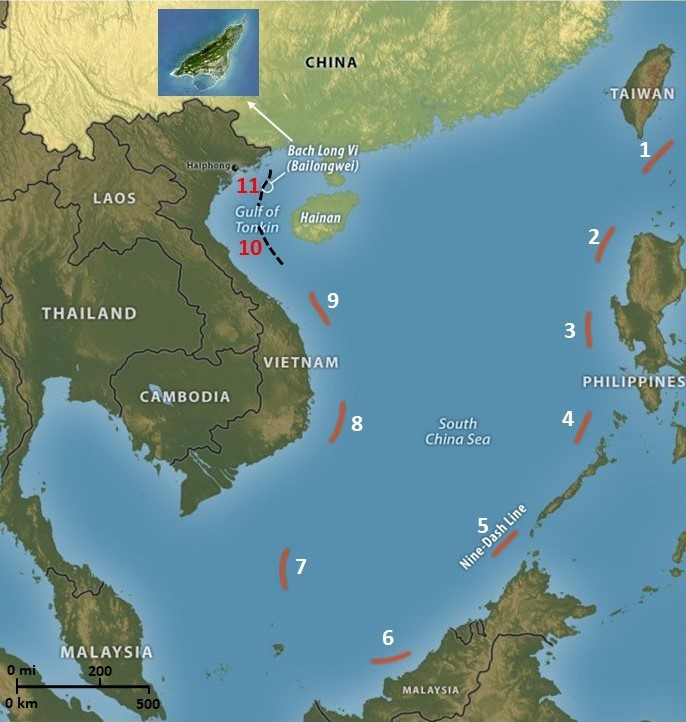
The South China Sea, including the Gulf of Tonkin and Bach Long Vi Island. The nine-dash line and the eleven-dash line are also shown.
The Island and Its History, in Brief
In 1947, soon after the end of World War II, the government of the Republic of China (ROC) published a map of the location of the South China Sea islands claimed by China, using eleven dashed lines to enclose the South China Sea. Because it is shaped like the English letter U, it is also called the U-shaped line. The 10th and the 11th lines (in black on the map above) are located within the Gulf of Tonkin and include BLV as part of Chinese territory. In 1949, the People’s Republic of China was established and inherited the same territory. In 1953, in a show of friendship to Vietnam, Chinese Premier Zhou Enlai deleted the two lines in the Gulf of Tonkin, is the northwest arm of the South China Sea, bounded by China (north and east) and Vietnam (west). This is the origin of the now-famous nine-dash line.
“Bạch Long Vi” in Vietnamese means “the tail of the white dragon” (Bailongwei in Chinese). On international maritime maps, BLV was also called “Nightingale Island” (Night-in-gale), meaning “night of strong wind,” since the island served as a shelter for fishermen during storms. Until the 1950s, the island was also called Yeying Dao or Fushuizhou in Chinese.
BLV is at the center of the Gulf of Tonkin and is now a district of Haiphong City, Vietnam. It spans 1.78 square kilometers at high tide and 3.05 square kilometers during low tide. The island has a triangular shape, 3 km long, 1.5 km wide, with a perimeter of about 6.5 km. It sits 58 m above sea level, about 110 km from Haiphong (Vietnam) and 120 km from Hainan Island (China). There are no other significant islands within 75 km of BLV.
Due to its warm climate and unique location, BLV has abundant natural resources. The waters of BLV are rich in seafood. Among them, abalone is the most famous. Red fish, grouper, squid, sea cucumber, sea turtle, pearls, shrimps, and crabs are also abundant. The surrounding seabed is also rich in oil and gas.
In the 19th century, according to the Annals of the Dan County (China), Chinese fishermen used BLV as a transitional post to ship cargo to the cities of Vietnam and as a storm shelter. The Chinese fishermen also built a temple on the island, which housed an iron bell casted in 1887.
In 1887, France imposed a colonial system over Vietnam, which it called French Indochina. The French and the Chinese Qing Dynasty signed the Sino-French Treaty of 1887 to divide the Gulf of Tonkin. The treaty placed BLV under French control, although it was probably not realized at the time, since the French had no sovereign intentions toward BLV for a long time. Except for occasional patrolling, neither side showed any interest in annexing the island. Some foreign scholars regarded this island as China’s territory at least to the 1950s.
Until the early 20th century, there were no permanent inhabitants on BLV as there was no known fresh water source. The island was used as a storm shelter for fishermen. Fresh water was found in the south of the island in the 1920s. After that, Chinese and Vietnamese fishermen came to live on the island, practicing animal husbandry, farming, and fishing. The government of Guangdong province in China also sent officials to inspect the island and produced official reports in the 1930s.
After World War II broke out, Japan overtook France in Indochina and sent troops to the island. Japan was defeated by the Allies in August 1945 and left Indochina; France returned to Indochina in 1946.
In 1949, the Nationalist Party of China (KMT) lost the civil war in China and fled to Taiwan. A group of KMT army and officials fled from Hainan to BLV in the spring of 1950 and formed a local government on the island. By 1954, there were more than 100 households and over 500 people on the island. During this period, there were also French ships patrolling around the island. The Chinese People’s Liberation Army on Hainan Island did not attack the KMT remnants on the island in order to avoid a potential international dispute with the French.
In 1954, France lost the war in Vietnam. According to the Geneva Accords, Vietnam was divided between the French army (South) and the Vietnamese People’s Army (North). In August 1954, the French and the remnants of the KMT on the island, along with 71 households and 269 people, left BLV to retreat to South Vietnam.
On July 28, 1955, the Chinese People’s Liberation Army landed on the island, ousted dozens of the KMT remnants left by the French army, and set up a district-level administrative unit (called Fushuizhou municipal government), which was a part of the Dan county, Hainan Island. At that time, BLV had 64 households and 248 residents, including 130 males and 118 females. Except for three unidentified children, all were Chinese citizens. In addition to agriculture, the people on the island also established banking services, supply and marketing cooperatives, schools, fishery production cooperatives, etc.
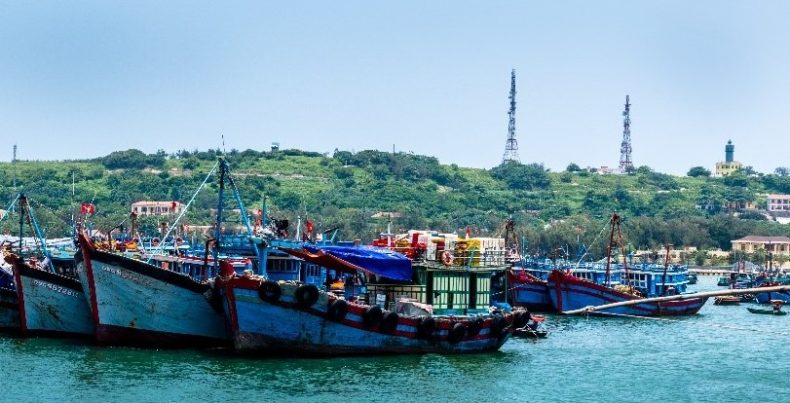
Bach Long Vi Island. The lighthouse on the right is the tallest in the Gulf of Tonkin. Radar and communication towers are also visible. Photo by Zhen-Gang Ji.
The Secret Transfer
As the involvement of the United States in the Vietnam War intensified in the 1950s, North Vietnam wanted to increase the warning time for providing air defenses in Haiphong and Hanoi. BLV was an excellent location for building a radar station. In 1957, Ho Chi Minh, the leader of North Vietnam, came to Beijing and requested that Chinese Premier Zhou Enlai ask Chairman Mao Zedong for the island to be ceded to Vietnam.
China, as a member of the world communist movement, was expected to support Ho Chi Minh’s Viet Cong in its war with South Vietnam supported by the United States. On the other hand, China had just ended the Korean War and did not want to be directly involved in another war with the United States. Transferring BLV to North Vietnam was a way to avoid direct military confrontation between China and the United States. At the time, China and North Vietnam had a very close relationship, often referred to as “comrades and brothers.” Mao Zedong agreed to hand over BLV in the name of their revolutionary friendship and common anti-American goal.
The official transfer ceremony was held on the island in March 1957. General Ma Baishan, the deputy commander of the Chinese army in Hainan, was the representative of China to hand over the island to Vietnam. The representative from Vietnam was also a deputy commander of a military division. According to General Ma, the secret agreement was that the Chinese military troops would leave but the local civilians would stay. The facilities of the Chinese government and organizations, such as shops, schools, and office buildings, were handed over to Vietnam as gifts. However, after hearing the Chinese fishermen on the island say: “We are Chinese, why now become Vietnamese?” Ma came to regret the deal. In a later interview, he said, “I was thinking a lot about it, it seems that I made a mistake.”
After the handover, China did help Vietnam build a radar station on the island. A large amount of aid materials was also transported to the Viet Cong through the island in the coming decades.
At the end of 1965, as the Vietnam War escalated, the U.S. Air Force intensified its bombing of North Vietnam, causing all civilians on the island to evacuate to the mainland. From then until 1992, there were only armed forces on BLV. At the end of 1992, the Vietnamese government encouraged and assisted some families, volunteers, and fishermen to return and settle down on the island.
Under the Agreement on the Delimitation of the Tonkin Gulf, signed on December 25, 2000 between China and Vietnam, BLV is clearly stated to belong to Vietnam. According to the Agreement, Vietnam is accorded 53.23 percent of the Gulf of Tonkin (including BLV) and China has 46.77 percent of the area. The line of delimitation is 15 nautical miles from BLV.
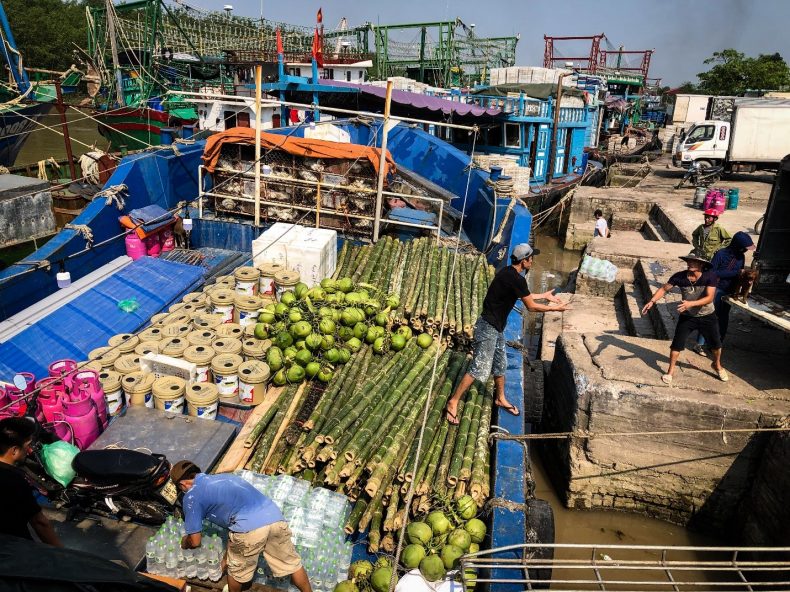
The seaport in Haiphong and the ship to BLV. Photo by Zhen-Gang Ji.
My Visit to BLV
I have been interested in BLV and its history for some years. I made two trips from the United States to Haiphong, Vietnam in the past two years, with the primary purpose of visiting the island. My first trip was in September 2017. I could not find a ship from Haiphong to BLV during my stay and had to leave Vietnam without seeing the island.
In early 2019, I started to prepare for my second trip. Having learned from my first trip, I was fully aware of the importance of local knowledge and connections. I contacted a Vietnamese interpreter and had him prepare my trip before my arrival in Haiphong.
The interpreter and I left the hotel in Haiphong for the seaport on Saturday, May 18, 2019 at 7 a.m. It took a little more than an hour of driving to get there. It was a dirty, smelly, and crowded small seaport, full of fishing boats. Our ship carried both cargo and passengers. People were busy loading cargo onto the ship; the deck was full of bamboo, paint cans, coconuts, propane tanks, and other goods. At the foredeck, there were live chicken, ducks, and a goat.
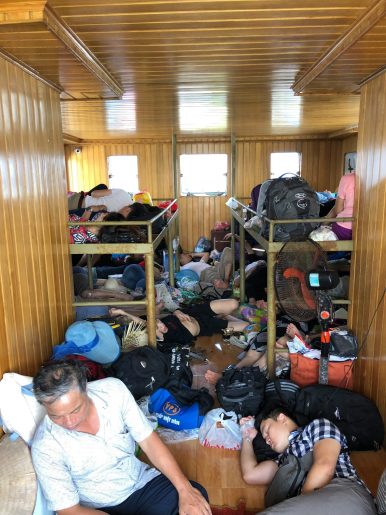
The ship to BLV, full of passengers. Photo by Zhen-Gang Ji.
At 9 a.m., the ship left port. After picking up more passengers at Cat Ba Island, the ship was so full that there was almost nowhere to sit. After we left Cat Ba Island, the ship headed directly toward BLV. The sea was rough and the ship was so overloaded with people and cargo that the waves lapped onto the deck. Another sign that the ship was over its capacity: since the stern was so low, the seawater flooded the toilet floor directly via the drain pipe.
We arrived at the island around 5:30 p.m., eight and a half hours after we left the seaport. Immediately upon our arrival, we were greeted by numerous uniformed officers. Some passengers remarked that it was very unusual. I took my luggage and got ready to disembark. One plainclothes officer noticed me and ask for my ID. I gave him my passport. He told me that this island is a military restricted area and foreigners are not allowed to enter. A uniformed captain also approached me. Via my interpreter, he told me that I could not set foot on the island and must stay on the ship and return with the ship next day.
I argued my case to the officers. First, the websites of the Vietnamese government never mentioned that BLV is a military restricted area and foreigners are not allowed. Second, When I entered Vietnam at the Hanoi airport, I told the border security officer that I was going to Haiphong. He did not tell me that BLV, a district of Haiphong, was off limits for foreigners. I was fully authorized to visit Haiphong; why could not I visit BLV? Finally, my interpreter has lived in Haiphong for his entire life. He did not know about the restrictions either. How could I know?
The officers could not give any good response. After hours of delay, they finally agreed that I could leave the ship and spend the night on the island.
The locals also told me that no foreigners are allowed to enter the island; the few who indeed came were prohibited from disembarking. But I was fortunate enough to spend a night on BLV and see the island for myself – including tasting its famous abalone.
BLV, home to less than 1,000 residents, is a small island by any standard. The island has a few small restaurants, no hotel, and two narrow streets. Currently, the municipal government of BLV manages 85.2 percent of the island and the military manages the remaining 14.8 percent. Economic development has been rapid in recent years, including logistics, oil and gas, banking, insurance, marine medicine, and finance. With a harbor that went into operation in 2000, the island provides storm shelters for about 11,000 fishing boats each year. A new water reservoir provides additional fresh water and is helpful for more people to settle on the island. BLV has the potential to become a hub of ecotourism, trade and commerce, and agro-fishery in the future. Vietnam will reap those benefits – all thanks to China’s gift of the island six decades ago.
Conclusion
Today, the South China have emerged as a flashpoint, not only among the various claimant but also for U.S.-China relations. In contrast to these heated maritime disputes, in 1957, China and Vietnam had a secret (and friendly) agreement to transfer BLV from China to Vietnam and make the local Chinese residents become Vietnamese. Since then, China has officially acknowledged Vietnam’s sovereignty over BLV through a series of agreements as a part of the border demarcation of the Gulf of Tonkin in the 2000s.
BLV is an authentic island, meaning there is no dispute over whether it is an island or a reef. In accordance with the 1982 UN Convention on the Law of the Sea, Vietnam has demanded sovereign rights and an exclusive economic zone (EEZ) covering large areas of the Gulf of Tonkin and the continental shelf, on the grounds that BLV is Vietnamese territory. The transfer of BLV thus made China lose a significant portion of its interests in the area and affected the livelihoods of hundreds of thousands of Chinese people. This pearl in the Gulf of Tonkin has been lost to China forever.

